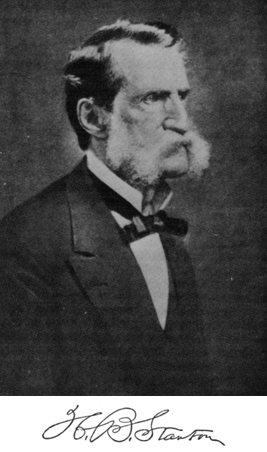Henry Brewster Stanton facts for kids
Quick facts for kids
Henry Brewster Stanton
|
|
|---|---|
 |
|
| Born | June 27, 1805 Preston, Connecticut, U.S.
|
| Died | January 14, 1887 (aged 81) New York City, U.S.
|
| Occupation |
|
| Spouse(s) | |
| Children | 8, including Theodore and Harriot |
| Relatives |
|
Henry Brewster Stanton (born June 27, 1805 – died January 14, 1887) was an important American figure. He was an abolitionist, which means he worked to end slavery. He was also a social reformer, a lawyer, a journalist, and a politician.
Henry Stanton wrote for famous newspapers like the New York Tribune and the New York Sun. He also wrote for anti-slavery papers such as Anti-Slavery Standard and The Liberator. In 1850 and 1851, he was elected to the New York State Senate. His wife, Elizabeth Cady Stanton, was a very famous leader in the early women's rights movement.
Contents
Henry Stanton's Early Life and Beliefs
Henry Brewster Stanton was born on June 27, 1805, in Preston, Connecticut. His parents were Joseph Stanton and Susan M. Brewster. His father made woolen goods and traded with the West Indies.
Henry remembered that his desire for fairness for all people started when he was a child. He once heard a slave sing a sad song. This song deeply affected him and shaped his future. He decided that he wanted to fight for the rights of oppressed people in his country.
Henry Stanton's Career as a Reformer
Henry Stanton became well known as a great speaker and writer. He used these skills as a journalist, lawyer, and politician.
Becoming a Journalist and Writer
In 1826, Stanton began writing for the Monroe Telegraph in Rochester, New York. He also started giving political speeches. Later, he wrote for the New York Tribune and the New York Sun. He also wrote for William Lloyd Garrison's anti-slavery newspapers, Anti-Slavery Standard and The Liberator.
His Work as an Abolitionist
Stanton began studying at the Oneida Institute. However, he soon left to join the abolitionist movement. After he got married, Stanton studied law under his father-in-law, Daniel Cady. He became a patent attorney in Boston, Massachusetts. Both he and his wife were very active in the movement to end slavery.
Due to Henry's health, his family moved to Seneca Falls (CDP), New York, in 1847. There, he continued his work as a reformer, journalist, and politician. He often traveled, spoke, and wrote to support the end of slavery.
While living in Seneca Falls, Stanton helped create the Free Soil Party in 1848. He also helped start the Republican Party in 1856. He was elected as a member of the New York State Senate in 1850 and 1851.
Henry Stanton was known as one of the best speakers on social issues in America. He was a main spokesperson for the abolitionist movement before the American Civil War. He was especially good at speaking without notes. His wife said that people sometimes asked him to speak on a random topic just for fun!
Traveling for Social Causes
In 1840, Henry Stanton went to the first World Anti-Slavery Convention in London. After that, he spent several months traveling in Europe. He gave anti-slavery speeches in many major cities in England, Scotland, Ireland, and France.
Throughout their lives, Henry and Elizabeth Cady Stanton traveled a lot. They spoke and organized for many social causes. These included temperance (reducing alcohol use), abolition (ending slavery), and women's rights.
Frederick Douglass, a famous abolitionist and former slave, remembered hearing Henry B. Stanton speak. He told Henry's son, Theodore, about it: "Your father was then without a doubt the best speaker in the anti-slavery movement. I listened to him many times, but the first time, when I had just escaped slavery, touched me the most deeply."
Other Public Service Roles
Henry Stanton was active in politics and social issues his whole life. He served as Deputy County Clerk of Monroe County, New York, for three years. He was also the secretary of the American Anti-Slavery Society from 1835 to 1840. From 1861 to 1863, Stanton was appointed Deputy Collector of the Port of New York.
Stanton wrote many pamphlets about social issues. He also wrote a book called Sketches of Reforms and Reformers in Great Britain and Ireland (1849). This book looked at social conditions and activists in Britain. He was also finishing the fourth edition of his autobiography, Random Recollections (1885), when he passed away.
Henry Stanton's Family Life
Henry's wife, Elizabeth Cady Stanton, was a cousin of Gerrit Smith. She became very involved in important social issues. She worked for temperance, the end of slavery, women's rights, and universal suffrage (the right for everyone to vote).
Henry and Elizabeth were married on May 1, 1840. Their wedding trip was to Europe, where Henry was a delegate to the World Anti-Slavery Convention in London. This convention started on June 12, 1840.
Together, Henry and Elizabeth had seven children:
- Daniel Cady Stanton (1842-1891)
- Henry Brewster Stanton, Jr. (1844-1903)
- Gerrit Smith Stanton (1845-1927)
- Theodore Weld Stanton (1851-1925)
- Margaret Livingston Stanton Lawrence (1852-1938)
- Harriot Eaton Stanton Blatch (1856-1940)
- Robert Livingston Stanton (1859-1920)
Henry Stanton died from pneumonia on January 14, 1887, in New York City. At the time of his death, his wife Elizabeth was in London, speaking about women's voting rights.
Images for kids


